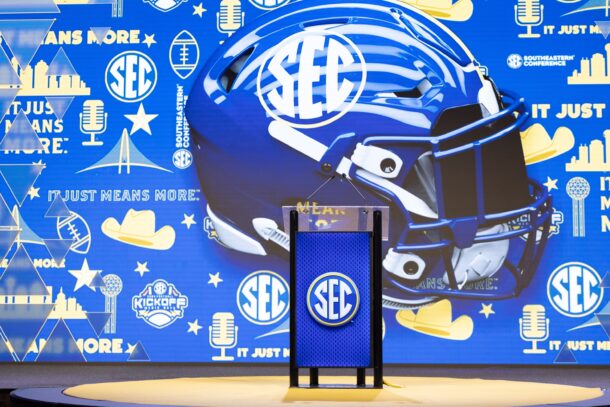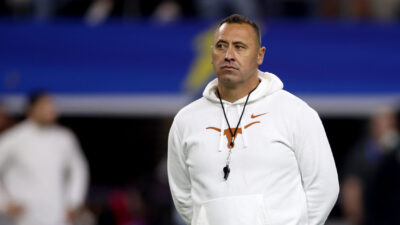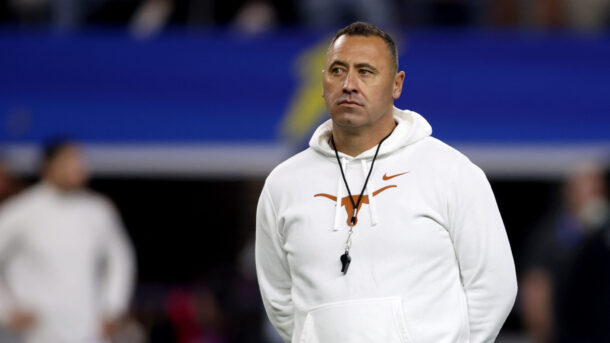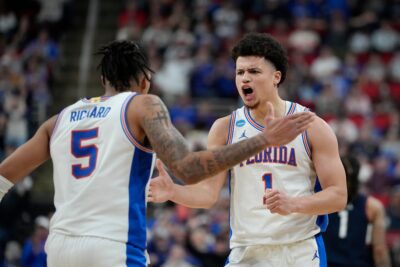Ad Disclosure
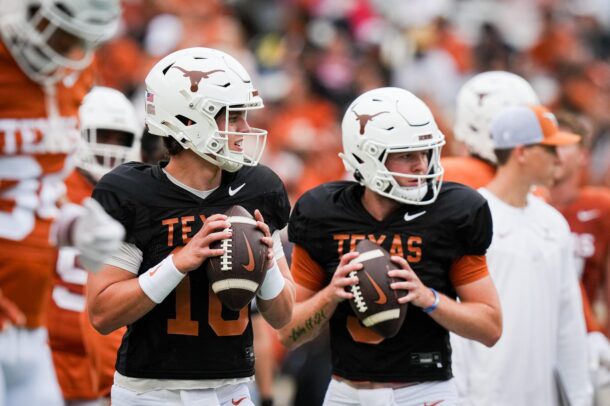
Texas, if the situation wasn’t quite so enviable, might have a very uncomfortable conversation going on this offseason. The Longhorns are a College Football Playoff contender — not just to make the field but to win the thing — and that means the mercurial backup quarterback will have to sit and wait 1 more year.
No, it’s not Arch Manning time yet. We’ll see Quinn Ewers yet again, a fourth-year who has started 22 games for Texas since transferring from Ohio State. Ewers threw for 22 touchdowns last season, adding 5 more scores on the ground, and only gave the ball away 6 times on 394 pass attempts (1.5% interception rate).
Individual numbers weren’t elite by any means for the Southlake native, but he piloted an offense that ranked 13th in overall efficiency and 15th in scoring.
Given the circumstances, coach Steve Sarkisian would be quite the riverboat gambler to replace an entrenched starter with a big-name youngster because of a spring showcase. Texas feels like it is ready to compete for the SEC title in Year 1, and doing so would make for a foolproof CFP case.
The Longhorns’ returning production (a formulate from ESPN’s Bill Connelly) is a top-40 mark nationally. Of the 8 players who saw at least 100 snaps on the offensive line last year, 7 return, including future first-round tackle Kelvin Banks Jr. Xavier Worthy and Adonai Mitchell leave the wideout room, but there are reinforcements aplenty. Jonathan Brooks exits the backfield, but excitement abounds over CJ Baxter.
Frankly, there’s no reason to expect any slippage from this offense. The Longhorns could be better.
ESPN’s Football Power Index (FPI) would seemingly support that statement. ESPN’s model has the Longhorns at No. 3 in its recently released preseason projections.
Texas is projected 10.0 wins and 2.4 losses. The model gives the Longhorns a 6.8% chance to go unbeaten and a 24.2% chance to win the SEC.
Texas has a 67.8% chance to make the expanded College Football Playoff and a 20.6% chance to make the national championship game. The model gives Texas a 23.7% chance to secure a first-round bye in the Playoff.
It took them a bit to get up and roaring under Sarkisian, but last year was quite the breakthrough. UT won double-digit games for just the second time since 2009 and the first since 2018. The Longhorns won their first conference title since 2009. After toiling in excruciating mediocrity for years, the “is Texas back?” joke is officially dead.
They are.
And expectations are high.
So, anything short of steamrolling the early part of the schedule will induce some anxiety. After what happened in the Texas spring game, Ewers probably can’t afford a slow start against Colorado State on Aug. 31. With Manning at his heels, Ewers needs to deliver against Michigan at The Big House on Sept. 7.
If Texas were to start slowly, could we see something similar to what happened with Spencer Rattler and Caleb Williams several years ago in Norman?
Surely not, right?
According to FPI, Texas has the 10th toughest schedule in the FBS next season. This is the storyline that must be considered when looking at Texas. These things get weird.
Because FPI presents itself as a points-per-game metric, we can reverse-engineer point spreads to see how the model arrives at the win projections that are given. As a rule of thumb, I apply 2.5 points to account for home-field advantage.
Here’s what the Texas (22.9) schedule looks like:
- Colorado State (H): -33.8 spread, .999 win probability
- Michigan (A): -5.5 spread, .651 win probability
- UTSA (H): -23.8 spread, .999 win probability
- Louisiana-Monroe (H): -39.5 spread, .999 win probability
- Mississippi State (H): -21.9 spread, .999 win probability
- Oklahoma (N): -5.7 spread, .651 win probability
- Georgia (H): +1.4 spread, .475 win probability
- Vanderbilt (A): -22.6 spread, .999 win probability
- Florida (H): -15.3 spread, .881 win probability
- Arkansas (A): -15.8 spread, .886 win probability
- Kentucky (H): -19.2 spread, .973 win probability
- Texas A&M (A): -6.8 spread, .703 win probability
Add those all up and you get a projected 10.2 wins. ESPN’s own book (ESPN Bet) has the Longhorns over/under for regular-season wins set at 10.5, with +120 odds if you take the over. The under’s price is -150.
As was the case in the Alabama piece I wrote recently, DraftKings‘ “exact wins” prop looks more appealing for the Longhorns. You have to really believe in Ewers to back an 11-win regular season. DraftKings has +275 odds on exactly 10 wins for UT in the regular season. A $100 bet on Texas to win exactly 9 regular-season games would pay out $430.
21+ and present in NY, NJ, PA, CT, AZ, CO, IA, IL, IN, KS, KY, LA, MA, MD, MI, NC, NH, OH, OR, TN, VA, WV, WY. Gambling problem? Call 1-800-GAMBLER.
CLAIM OFFEROne thing that immediately jumps out is that UTSA game on Sept. 14. FPI would label Texas as a greater-than-3-touchdown favorite in that game, but watch out for the Roadrunners. Boise State and James Madison are the only Group of 5 schools ranked higher than UTSA in FPI.
Jeff Traylor is still with the program after being linked to just about every major Texas-based job in recent years. They’ve won 32 games together in the last 3 seasons, making the transition from Conference USA to the American last fall and going 7-1 in the debut.
If UTSA quarterback Owen McCown can effectively pick up the pieces from Frank Harris, the Roadrunners have plenty of experience and depth to be factors in the Playoff discussion.
All that to say anything over 20 on that game line, I’m leaning UTSA. They went to DKR 2 years ago and had a 3-0 lead after the first quarter. The 2 sides were tied at 17 going into halftime, but UTSA faded and lost by 21.
Last season, per ESPN’s David Hale, Ewers was automatic when Texas was down on the scoreboard. He completed 72.7% of his passes, averaged 10.3 yards per pass attempt, and picked up 20 yards or more on 15% of his throws.
Ewers also delivered 12 touchdowns against only 3 interceptions when he was blitzed. He handled pressure better last year than the year before, but this is the area to watch.
Texas will get stress-tested in the first 3 weeks of the season — first in Ann Arbor and then next at home against Traylor and UTSA. If the Longhorns find themselves trailing, if the pressure gets turned up, is Ewers as good?
Michigan has the best corner in the Big Ten and a future top-5 NFL Draft pick on the interior of its defensive line. Little needs to be said about the challenge that awaits Ewers and the Longhorn offense in Week 2.
UTSA ranked top-30 last season in yards-per-pass allowed and quarterback rating against. It was an all-or-nothing defense, as they were repeatedly gashed by chunk plays yet gave up a sub-60% completion rate and picked off 10 passes.
Edge Trey Moore was the premier pass-rusher last fall, and he has since transferred to Texas. Jimmori Robinson (25 pressures, 11 tackles for loss, 2 pass breakups) should step into the void nicely. Consider also that Texas will be working a new face in at right tackle.
The early stages of the 2024 season will be telling for Texas. Things could get wild in a hurry. Which isn’t to say that they will, but the potential for quarterback questions makes this team a touch harder to project. It’s tough to quantify how pressure from Manning could (or simply could not) impact Ewers on the field. He’s already having to replace his top 2 targets and his top running back.
Things are quiet on the homefront now. That can change quickly if the Longhorns aren’t humming out of the gates. The opener should be fairly straightforward. But there could be some money to be made going against the grain in Weeks 2 and 3.
Derek Peterson does a bit of everything, not unlike Taysom Hill. He has covered Oklahoma, Nebraska, the Pac-12, and now delivers CFB-wide content.
